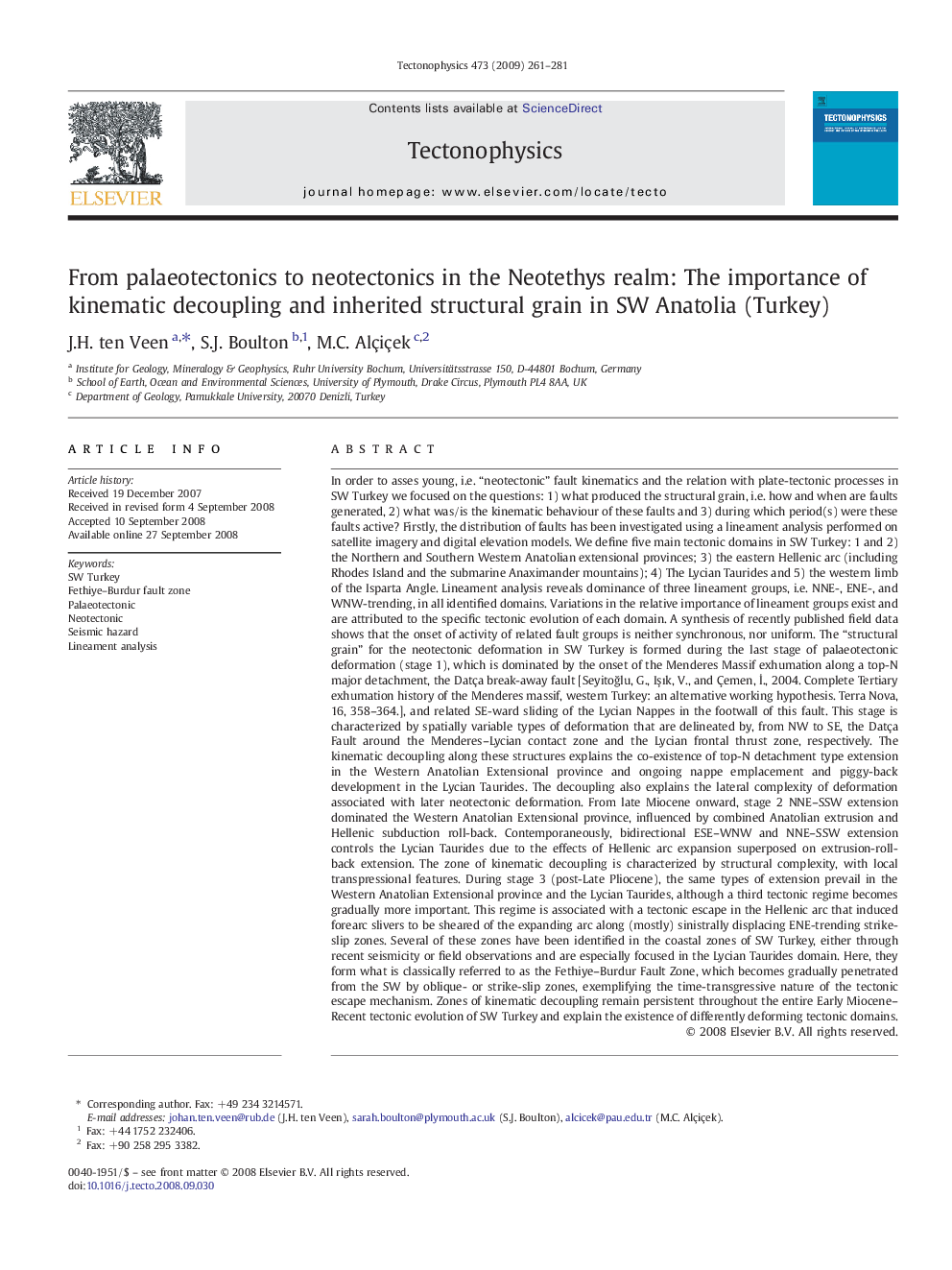| Article ID | Journal | Published Year | Pages | File Type |
|---|---|---|---|---|
| 4694005 | Tectonophysics | 2009 | 21 Pages |
In order to asses young, i.e. “neotectonic” fault kinematics and the relation with plate-tectonic processes in SW Turkey we focused on the questions: 1) what produced the structural grain, i.e. how and when are faults generated, 2) what was/is the kinematic behaviour of these faults and 3) during which period(s) were these faults active? Firstly, the distribution of faults has been investigated using a lineament analysis performed on satellite imagery and digital elevation models. We define five main tectonic domains in SW Turkey: 1 and 2) the Northern and Southern Western Anatolian extensional provinces; 3) the eastern Hellenic arc (including Rhodes Island and the submarine Anaximander mountains); 4) The Lycian Taurides and 5) the western limb of the Isparta Angle. Lineament analysis reveals dominance of three lineament groups, i.e. NNE-, ENE-, and WNW-trending, in all identified domains. Variations in the relative importance of lineament groups exist and are attributed to the specific tectonic evolution of each domain. A synthesis of recently published field data shows that the onset of activity of related fault groups is neither synchronous, nor uniform. The “structural grain” for the neotectonic deformation in SW Turkey is formed during the last stage of palaeotectonic deformation (stage 1), which is dominated by the onset of the Menderes Massif exhumation along a top-N major detachment, the Datça break-away fault [Seyitoğlu, G., Işık, V., and Çemen, İ., 2004. Complete Tertiary exhumation history of the Menderes massif, western Turkey: an alternative working hypothesis. Terra Nova, 16, 358–364.], and related SE-ward sliding of the Lycian Nappes in the footwall of this fault. This stage is characterized by spatially variable types of deformation that are delineated by, from NW to SE, the Datça Fault around the Menderes–Lycian contact zone and the Lycian frontal thrust zone, respectively. The kinematic decoupling along these structures explains the co-existence of top-N detachment type extension in the Western Anatolian Extensional province and ongoing nappe emplacement and piggy-back development in the Lycian Taurides. The decoupling also explains the lateral complexity of deformation associated with later neotectonic deformation. From late Miocene onward, stage 2 NNE–SSW extension dominated the Western Anatolian Extensional province, influenced by combined Anatolian extrusion and Hellenic subduction roll-back. Contemporaneously, bidirectional ESE–WNW and NNE–SSW extension controls the Lycian Taurides due to the effects of Hellenic arc expansion superposed on extrusion-roll-back extension. The zone of kinematic decoupling is characterized by structural complexity, with local transpressional features. During stage 3 (post-Late Pliocene), the same types of extension prevail in the Western Anatolian Extensional province and the Lycian Taurides, although a third tectonic regime becomes gradually more important. This regime is associated with a tectonic escape in the Hellenic arc that induced forearc slivers to be sheared of the expanding arc along (mostly) sinistrally displacing ENE-trending strike-slip zones. Several of these zones have been identified in the coastal zones of SW Turkey, either through recent seismicity or field observations and are especially focused in the Lycian Taurides domain. Here, they form what is classically referred to as the Fethiye–Burdur Fault Zone, which becomes gradually penetrated from the SW by oblique- or strike-slip zones, exemplifying the time-transgressive nature of the tectonic escape mechanism. Zones of kinematic decoupling remain persistent throughout the entire Early Miocene–Recent tectonic evolution of SW Turkey and explain the existence of differently deforming tectonic domains.
